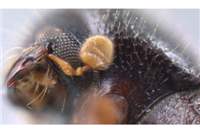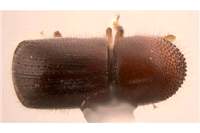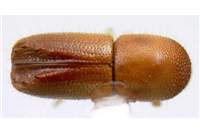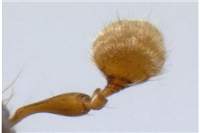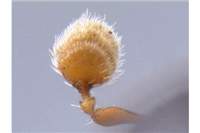Diagnosis
Similar to Ambrosiodmus, except no asperities on pronotal disc, and lateral profile of pronotal disc is flat, not rounded. Ecologically, many species of Ambrosiodmus are mycocleptic (Hulcr & Cognato, 2010b), unlike Ambrosiodmus.
Similar to Stictodex, except antennal club type 3 (not 2), club approximately rounded (not broad), striae 1 parallel (as opposed to divergent), elytral declivity steep.
Distribution
Mostly tropical and temperate Asia, Ambrosiophilus atratus introduced to North America and Europe.
Biology
Many tropical species appear to be adapted to mycocleptism. They seek established galleries of unrelated Xyleborini and create their galleries in close proximity. This allows them to utilize the symbiotic fungus originating in the hosts' gallery. The most widespread A. atratus is however not mycocleptic.
Taxonomy
Monophyletic status of this genus was confirmed in a molecular analysis by Cognato et al. (2010).
Detailed description
Eyes shallowly emarginate, upper part smaller than lower part. Antennal club approximately circular, variable, mostly type three (with segment 1 straight or convex), or four (segment 1 small, second and third prominent on both sides). Margin of first club segment straight (may be slightly concave or convex) on anterior face, mostly costate, may appear soft (pubescent) on posterior side. Segment 2 visible on both sides of club, soft, non-corneous or corneous part on anterior side only, rarely corneous on both sides of club. Segment 3 clearly visible on both sides of club. Segment 1 of antennal funicle shorter than pedicel, funicle 4-segmented, scapus regularly thick. Frons above epistoma mostly smooth, alutaceous, with minor punctures, or rugged, coarsely punctate. Submentum flat, flush with genae, or slightly impressed, shaped as very narrow triangle. Anterior edge of pronotum with no conspicuous row of serrations. Pronotum from lateral view tall (type 2), flat disc and rounded anteriad, or inflated anteriad (type 4), rarely basic shape (type 0). Pronotum from dorsal view basic, short, parallel-sided, rounded frontally (type 2). Pronotal disc densely and evenly punctured, no asperities. Lateral edge of pronotum obliquely costate. Procoxae contiguous, prosternal posterocoxal process short and conical, or flat and inconspicuous, or tall and pointed, or conical and slightly inflated. Tuft on pronotal basis associated with mesonotal mycangium absent, also setae on elytral bases associated with elytral mycangium absent. Scutellum flat, flush with elytra. Elytral bases straight, with oblique edge, elytral disc longer than declivity, flat, elytral disc with distinct punctures in strial lines. Lateral profile of elytral declivity flat or slightly convex or rounded, steep to very steep. Dorsal profile of elytral apex rounded, often broadened laterally. In one species (A. sexdentatus) declivity excavated. Declivity with few setae or scales, not conspicuously pubescent. Posterolateral declivital costa ending in 7th interstriae. Inner part of declivity has no tubercles on interstria 1 (sutural), several tubercles on interstriae 2, 3 and beyond. First interstriae parallel (sometimes slightly broadened towards elytral summit). Protibiae with evenly rounded edge, or obliquely triangular, broadest at 2/3 of length. Posterior side of protibia flat, no granules. Protibial denticles large, distinctly longer than wide, bases of denticles not enlarged or only slightly enlarged, between 6 and 8 denticles present. Body length 2.4 to 3.2 mm. Mostly black, sometimes dark brown.



